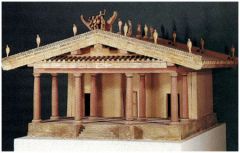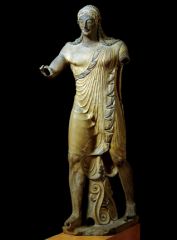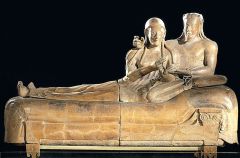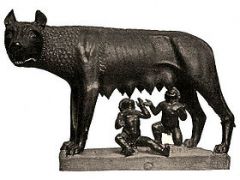![]()
![]()
![]()
Use LEFT and RIGHT arrow keys to navigate between flashcards;
Use UP and DOWN arrow keys to flip the card;
H to show hint;
A reads text to speech;
5 Cards in this Set
- Front
- Back

|
Model of a typical sixth-century BCE Etruscan temple as described by Vitruvius.
EARLY ETRUSCAN ART Etruscan temples resembled Greek temples but had widely spaced unfluted wooden columns only at the front, walls of sun-dried mud-brick, and a narrow staircase at the center of their facade. |
|

|
Apulu (Apollo) from the roof of the Portonaccio temple, Veii, Italy,
ca. 510-500 BCE EARLY ETRUSCAN ART Painted Terracotta The Veii Apulu was part of a statuary group depicting a Greek myth. Distinctly Etruscan, however, are the god's vigorous motion and gesticulating arms and the placement of the statue on a temple roof. |
|

|
Sarcophagus with reclining couple, from Cerveteri, Italy, ca. 520 BCE,
Painted Terracotta EARLY ETRUSCAN ART Sarcophagi in the form of a husband and wife on a dining couch have no parallels in Greece. The artist's focus on the upper half of the figures and the empathic gestures are Etruscan hallmarks. |
|

|
Interior of the Tomb of the Leopards, Tarquina, Italy,
ca. 480 - 470 BCE EARLY ETRUSCAN ART Mural paintings adorn many of the underground tombs at Tarquina. In this tomb, banqueting couples, servants and musicians celebrate the joys of the good life. The men have dark skin, the women fair skin. |
|

|
Capitoline Wolf, from Rome, Italy
ca. 500 - 480 BCE Bronze Musei Capitolini, Rome LATER ETRUSCAN ART An Etruscan sculptor cast this bronze statue of the she-wolf that nursed the infants Romulus and Remus, founders of Rome. The animal has a tense, gaunt body and an unforgettable psychic intensity. |

